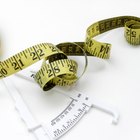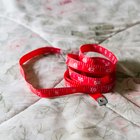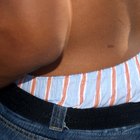Men's shirt sizing isn't always clear cut, especially when you're used to looking simply for small, medium or large. Knowing your measurements takes the guess work out of shirt shopping and helps you find the right fit every time.
Breaking Down the Numbers
Dress-shirt sizing typically features two numbers that represent key measurements.
Neck Size
The first number on a shirt label indicates your neck size. Measure your neck at the Adam's apple level. Add about a 1/2 inch to the measurement, which will ensure your dress shirt isn't too snug.
Arm Length
The second number in dress-shirt measurements represents your arm length. This measurement represents the length of your arm, from the center of the back of your neck to your wrist.
Waist Size: An Occasional Measurement
You've figured out that you're a 15 1/2 x 34 shirt size, but find yourself confused when you pick up a new brand and see a third measurement listed on the tag. Some designers also include a waist measurement when sizing shirts. Fortunately, you already know this number -- just check to see what size pants you're wearing. Again, when in doubt, size up.
Understanding Shirt Cuts
You might also notice that your label includes a description of the shirt's cut. Choose one that best flatters your silhouette:
- Slim fit: Slim-fit shirts hug the body. When trying on this style, make sure you can pinch at least an inch of fabric in the chest and waist and that the shoulder seams hit at the end of the shoulder.
- Athletic cut: This style of shirt features a broad chest, shoulders and arms with a narrower waist.
- Regular cut: The standard style, regular-size shirts are looser than slim fit and should give you 2 to 3 inches of fabric to pinch in the chest and waist.
- Full cut: This style features a wider bottom of the shirt than the regular cut, giving more room in the waistline for men who carry weight around their midsection.
Finding Your Size
While fit does vary by brand, generally, you can take your neck and arm measurements and translate them into a standard small, medium, large or extra-large shirt size.
- Small: Men with a neck size between 14 and 15 inches and arm length of 32 to 33 inches usually wear a size small.
- Medium: Medium builds have a neck size between 15 and 16 and arms that measure 33 to 34 inches.
- Large: Large shirts are cut for men with necks that measure between 16 and 17 inches and arms around 35 inches long.
- Extra Large: Men with necks exceeding 17 inches and arms at least 36 inches long should wear an XL.
Related Articles

What Is XXXL in Sizes?

What Size Shirt Is a 4X for Men?

How to Measure a Man's Shirt Size

Ideal Weight Vs. Dress Size

How to Convert Men's Clothing Sizes to ...

How to Size Overalls

How to Determine Boxer Brief Size

How Should Men With Big Stomachs Wear ...

How to Buy Jeans for Girls With Wide ...

How to Sew a Gusset on a Sleeve

How do I Convert Men's Underwear Sizes ...

The Differences Between Slim Fit and ...

The Difference Between the Hourglass & ...

How to Size a Bathrobe

Difference Between 44S & 44R Suits

What Does Bust Size Mean?

How to Dress When You Have No Butt

How to Convert Girls' Clothing Sizes to ...

How to Compare Men's Shoe Size to Boys' ...

How to Dress a Big Stomach & Small Legs
References
Writer Bio
Barbie Carpenter worked as a technical writer and editor in the defense industry for six years. She also served as a newspaper feature page editor and nationally syndicated columnist for the Hearst Corp. Carpenter holds a Bachelor of Science in journalism from the University of Florida and a graduate certificate in professional writing from the University of Central Florida.